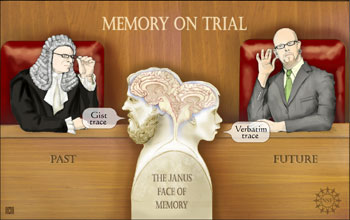Multimedia Gallery
Children's Memory May Be More Reliable
Scientists have found that humans exhibit two types of memory. One they call "verbatim trace," in which events are recorded very precisely and factually. Children have more "verbatim trace," but as they mature, they develop more and more of a second type of memory: "gist trace." "Gist trace" is where they recall the meaning of an event or its emotional flavor, but not precise facts. Gist trace is the most common cause of false memories, occurring most often in adults. Research shows that children are less likely to produce false memories, because gist trace develops slowly. As a result, children's recollections could be more reliable than those of adults, leading to ramifications in the courtroom. This illustration shows the Roman two-faced god, Janus, on trial. Symbolically, his bearded, mature head speaks to judges of yore, while the young boy's head is turned towards the judge of the future.
This image accompanied NSF press release, "Memory on Trial."
Credit: Zina Deretsky, National Science Foundation
Images and other media in the National Science Foundation Multimedia Gallery are available for use in print and electronic material by NSF employees, members of the media, university staff, teachers and the general public. All media in the gallery are intended for personal, educational and nonprofit/non-commercial use only.
Images credited to the National Science Foundation, a federal agency, are in the public domain. The images were created by employees of the United States Government as part of their official duties or prepared by contractors as "works for hire" for NSF. You may freely use NSF-credited images and, at your discretion, credit NSF with a "Courtesy: National Science Foundation" notation.
Additional information about general usage can be found in Conditions.
Also Available:
Download the high-resolution JPG version of the image. (986 KB)
Use your mouse to right-click (Mac users may need to Ctrl-click) the link above and choose the option that will save the file or target to your computer.



